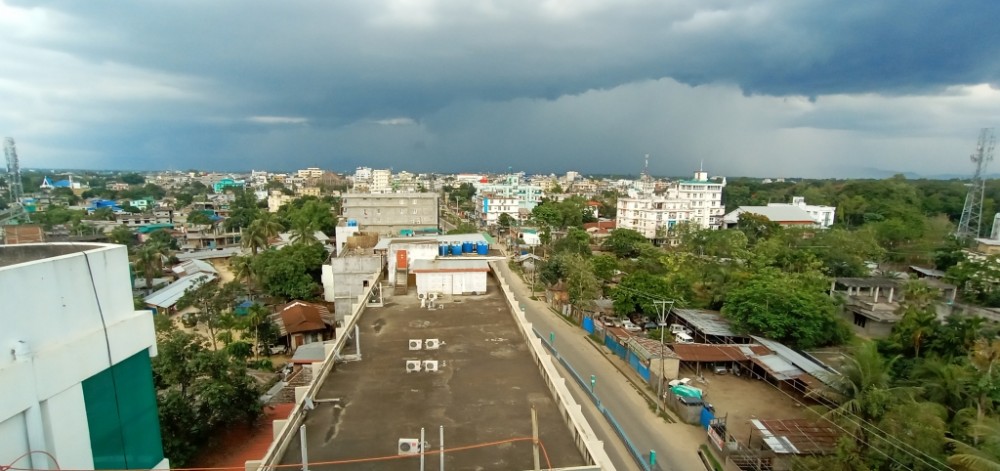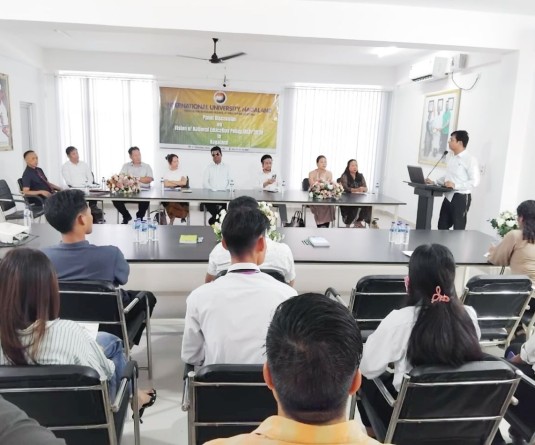A thick grey rain cloud loomed over the southern skies of Dimapur near foothills of Chümoukedima and adjoining areas. (File Photo)

‘Revitalize the global partnership for sustainable development’
Our Correspondent
Kohima |September 4
The Nagaland Sustainable Development Goals (SDGs) Vision 2030 in its Goal-17 on “Partnerships for the goals” aims to strengthen the means of implementation and revitalize the global partnership for sustainable development.” According to the vision statement, “By 2030 Nagaland will increase state level income and reduce fiscal deficit while aligning state level expenditure to Vision 2030 document.”
STRATEGIES FOR SUCCESS
Reducing fiscal deficit:
Two primary ways of bringing about a reduction in fiscal deficit are; seeking new ways of state-level revenue generation and reducing expenditure simultaneously.
In terms of debt consolidation and reaching targets under FRBM, there is still some scope for Nagaland to reach the 3 per cent level.
Innovative revenue raising efforts such as gaining proceeds from mine auctions can be initiated and revenue projects from GST will be accounted for, so as to improve the quality of budgeting.
Evaluation of a total view on public sector borrowing requirements including off-budget transactions, borrowing of the public sector undertakings and contingent liabilities will also be accounted for in advance.
“This would allow better management of the budgets, prior preparation and course-correction while engaging in continuous evaluation of the budget to take all possible efforts for reducing fiscal deficit.
Leveraging agricultural produce:
While 45 percent of Nagaland’s population is dependent upon agriculture, we see that the primary sector will accounts for only about 30 percent of GSVA at constant prices, the vision statement stated.
With the ‘crops’ sub-sector experiencing growth, the right market linkage channels and a structured programme around increase of organic products will help to increase GSVA, in turn enhancing state-level revenue and self- sufficient.
Innovations:
Apart from innovative financing mechanisms for long term investments, embedding innovative best practices that allow for effective implementation of scalable and sustainable programme is the way forward. Imbibing aspects of global, national and regional innovations and making them more locally relevant is of key importance.
The state government will take the lead to create a system whereby there is greater knowledge sharing of innovative initiatives and effective programme implementation in order to achieve the SDGs.
There are several innovative partnership- based sustainable models in the field of education, healthcare, livelihood generation that the Nagaland Vision 2030 document includes across the respective sections relating to the relevant goals.
Public Private Partnership:
Nagaland has a huge infrastructure deficit and to plug that gap, alongside ensuring that the state is more self-sufficient, the public -private partnership model could be an effective way.
As long term contracts between the government and one or more private entities, PPPs are usually undertaken for long-gestation construction and infrastructure related projects. However, they are not limited to such projects, they can be applied to just about any sector such as youth skill development training for livelihood generation, teacher training for quality education, water and sanitation services etc.
As an example, the Government of Nagaland, Christian Institute of Health Sciences and Research, Christian Medical College, Vellore and Emmanuel Health Association have partnered together to implement state level health programmes.
The role of CMC Vellore is to provide technical assistance to CIHSR to develop its technical departments, develop manpower, mentor its academic initiatives and aid its movement towards a centre of excellence.
The role of EHA as part of this collaboration is to provide direction, accountability, technical expertise and support from its extensive network.
The state has a lot more potential for uptake of PPP projects. Some of the ways in which such projects could be encourage include; increase ease of doing business ranking, setting up of a state infrastructure investment fund and formulate guidelines for PPP models, the vision statement stated.
Convergence of activities under government:
Cross-departmental interaction to be encouraged through workshops and brainstorming sessions to understand the possibilities of convergence of the various activities under the different programmes of the government.
This will go a long way in avoiding duplication of the activities and help bring scale as well as different perspectives and learning for success of government programmes.
Capacity building:
In order to allow for greater transparency, more accurate data collection methods and monitoring mechanism are necessary as capacity building tools at the state government level.
Developing dedicated technological infrastructure and utilizing the human resources available more effectively for data collection and analysis is an essential part of the capacity building process at the state level.
Consistently updating data points as identified in the State Indicator Framework and District Indicator Framework would go a long way to showcase progress especially to those stakeholders who may be keen to partner and finance projects in order to achieve specific targets.
A key part of capacity building efforts will be to engage in specialized training programmes.
The capacity building will be in the form of training programme, identifying needs, accessing best practices and conducting exposure visit.
“In order to help improve the state’s self-sufficiency, both financially and from a resource (human and capital) point of view, there is no doubt that partnering with the relevant stakeholders an innovative manner can yield positive results. Joining hands with the private sector, academia, NGOs and social enterprises will allow each one to leverage their strengths eventually leading to favourable outcomes,” the vision statement stated.
It also stated that in an interconnected world, new forms of multi-stakeholder partnership that are enabled with technological development and the right capacity building efforts are needed in order to mobilize and unlock the transformative power of tapping locally relevant resources for Nagaland’s Vision 2030.
Current status in Nagaland:
• Gross State Domestic Product (GSDP) in financial year 2018/2019 was Rs. 25, 986 crore and had grown by 10 per cent over the previous year. This is expected to increased to Rs. 27, 140 crore in 2019/2020, a growth of 4.44 percent over financial year 2018/2019.
• The state fiscal deficit in financial year 2018/2019 was 4.18 percent, an increase from 1.89 percent in financial year 2017/2018. This makes the fiscal deficit breaching the target of 3 per cent of GSDP set by Nagaland Fiscal Responsibility and Budget Management- FRBM (Amendment) Act 2011.
• Tertiary sector is the largest contributor to the Gross State Value Added (GSVA) with 58.37 per cent and the secondary sector is the smallest contributor with 12.25 per cent in financial year 2018/2019.
• Need for convergence of activities under various programmes of the government.
(This is the last part of 17 goals of Nagaland Sustainable Development Goals (SDGs) Vision 2030. ‘Nagaland Vision 2030: Leaving No one Behind’ is based on the 17 SDGs adopted by United Nations General Assembly in 2015. The Nagaland SDG Vision 2030 document has been prepared after extensive discussions based on the Strategy Paper and the Action Plan Programme of the departments. The document has been drafted by the SDG Coordination Centre under the guidance of the Department of Planning & Coordination, Nagaland incorporating contribution from various individuals and state government departments)





